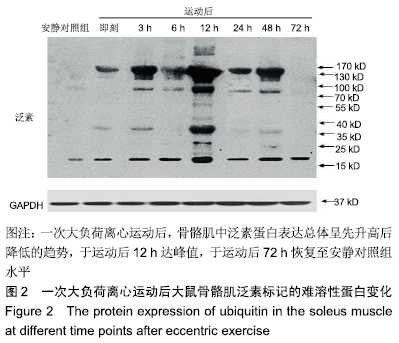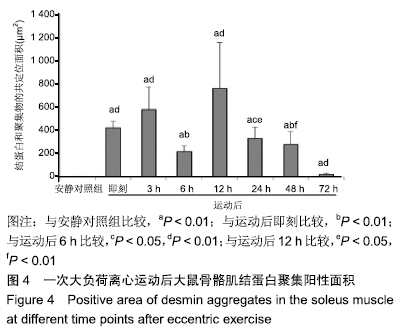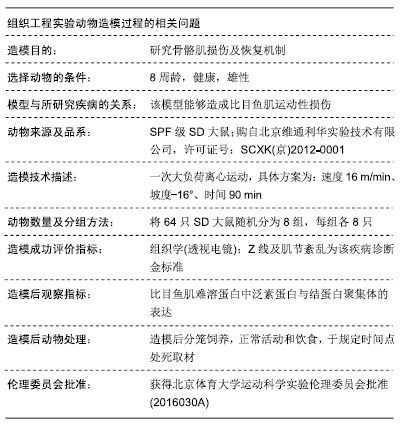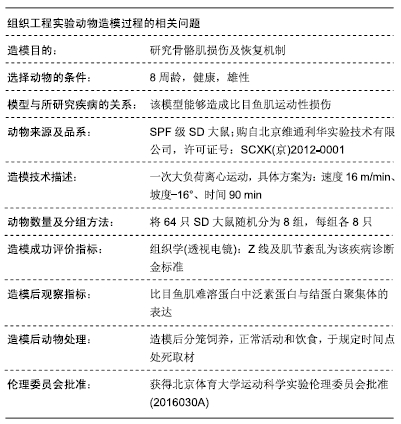[1] BUCHWALD-WERNER S, NAKA I, WILHELM M, et al.Effects of lemon verbena extract (Recoverben(R)) supplementation on muscle strength and recovery after exhaustive exercise: a randomized, placebo-controlled trial.J Int Soc Sports Nutr.2018; 15:5.
[2] BAUMERT P, G-REX CONSORTIUM, LAKE MJ, et al.TRIM63 (MuRF-1) gene polymorphism is associated with biomarkers of exercise- induced muscle damage.Physiol Genomics.2018;50(3): 142-143.
[3] PROSKE U, ALLEN TJ. Damage to skeletal muscle from eccentric exercise.Exerc Sport Sci Rev.2005;33(2):98-104.
[4] MACGREGOR LJ, HUNTER AM.High-threshold motor unit firing reflects force recovery following a bout of damaging eccentric exercise.PLoS One.2018;13(4):e0195051.
[5] SZCZYGLOWSKI MK, ADE CJ, CAMPBELL JA, et al.The effects of exercise-induced muscle damage on critical torque.Eur J Appl Physiol. 2017;117(11):2225-2236.
[6] 王瑞元,周越.骨骼肌与运动[M].北京:人民体育出版,2013:1-19.
[7] 王瑞元.一次力竭性离心运动后大鼠骨骼肌α-actin代谢、α-actin和MHC基因表达及针刺对其影响[D].北京:北京体育大学,2000.
[8] 周越.离心运动对骨骼肌细胞膜骨架蛋白含量影响的研究[D].北京:北京体育大学,2005.
[9] 李俊平.低氧、低氧运动对骨骼肌Titin和Nebulin的影响机理[D].北京:北京体育大学,2007.
[10] 袁建琴.低氧、离心运动对结蛋白的分布和表达的影响[D].北京:北京体育大学,2004.
[11] 徐玉明.低氧低氧运动对骨骼肌Dystrophin、Desmin的影响[D].北京:北京体育大学,2007.
[12] 马新东.运动后骨骼肌基质蛋白和完整膜蛋白变化及其对肌肉收缩和材料特性的影响[D].北京:北京体育大学,2006.
[13] WINTER L, WITTIG I, PEEVA V, et al.Mutant desmin substantially perturbs mitochondrial morphology, function and maintenance in skeletal muscle tissue.Acta Neuropathol.2016;132(3):453-473.
[14] DIERMEIER S, BUTTGEREIT A, SCHURMANN S, et al.Preaged remodeling of myofibrillar cytoarchitecture in skeletal muscle expressing R349P mutant desmin.Neurobiol Aging.2017;58: 77-87.
[15] DELORT F, SEGARD BD, HAKIBILEN C, et al.Alterations of redox dynamics and desmin post-translational modifications in skeletal muscle models of desminopathies.Exp Cell Res.2019; 111539.
[16] MCKENZIE EC, EYRICH LV, PAYTON ME, et al.Clinical, histopathological and metabolic responses following exercise in Arabian horses with a history of exertional rhabdomyolysis.Vet J. 2016; 216:196-201.
[17] KOUTAKIS P, MISERLIS D, MYERS SA, et al.Abnormal accumulation of desmin in gastrocnemius myofibers of patients with peripheral artery disease: associations with altered myofiber morphology and density, mitochondrial dysfunction and impaired limb function.J Histochem Cytochem.2015;63(4):256-269.
[18] KOPITO RR.Aggresomes,inclusion bodies and protein aggregation. Trends Cell Biol.2000;10(12):524-530.
[19] CAI S, ZHONG Y, LI Y, et al.Blockade of the formation of insoluble ubiquitinated protein aggregates by EGCG3"Me in the alloxan-induced diabetic kidney.PLoS One.2013;8(9):e75687.
[20] ARMSTRONG RB, OGILVIE RW, SCHWANE JA.Eccentric exercise-induced injury to rat skeletal muscle.J Appl Physiol Respir Environ Exerc Physiol.1983;54(1):80-93.
[21] SHANG H, XIA Z, BAI S, et al.Downhill Running Acutely Elicits Mitophagy in Rat Soleus Muscle.Med Sci Sports Exerc.2019;51(7): 1396-1403.
[22] 丁海丽,孙竹昕,王海牛,等.大负荷运动及针刺干预对大鼠骨骼肌内质网应激钙信号的影响[J].北京体育大学学报, 2017,40(11):49-55.
[23] SHEN D, COLEMAN J, CHAN E, et al.Novel cell- and tissue-based assays for detecting misfolded and aggregated protein accumulation within aggresomes and inclusion bodies.Cell Biochem Biophys.2011; 60(3):173-185.
[24] KOTHAWALA A, KILPATRICK K, NOVOA JA, et al.Quantitative analysis of alpha-synuclein solubility in living cells using split GFP complementation.PLoS One.2012;7(8):e43505.
[25] HODY S, CROISIER JL, BURY T, et al.Eccentric Muscle Contractions: Risks and Benefits. Front Physiol.2019;10:536.
[26] OWENS DJ, TWIST C, COBLEY JN, et al.Exercise-induced muscle damage: What is it, what causes it and what are the nutritional solutions?Eur J Sport Sci.2019;19(1):71-85.
[27] DABBS NC, CHANDER H.The Effects of Exercise Induced Muscle Damage on Knee Joint Torque and Balance Performance.Sports (Basel).2018;6(3).pii:E101.
[28] LEITE CMF, PROFETA VLDS, CHAVES SFN, et al.Does exercise-induced muscle damage impair subsequent motor skill learning? Hum Mov Sci.2019;67:102504.
[29] HOTFIEL T, MAYER I, HUETTEL M, et al.Accelerating Recovery from Exercise-Induced Muscle Injuries in Triathletes: Considerations for Olympic Distance Races.Sports (Basel).2019; 7(6).pii:E143.
[30] FRIDEN J, LIEBER RL.Eccentric exercise-induced injuries to contractile and cytoskeletal muscle fibre components.Acta Physiol Scand.2001;171(3):321-326.
[31] YU JG, CARLSSON L, THORNELL LE.Evidence for myofibril remodeling as opposed to myofibril damage in human muscles with DOMS: an ultrastructural and immunoelectron microscopic study. Histochem Cell Biol.2004;121(3):219-227.
[32] 张学林.骨骼肌过劳性损伤组织学成因及针刺预防和治疗效应[D].北京:北京体育大学,2010.
[33] NAUGHTON M, MILLER J, SLATER GJ.Impact-Induced Muscle Damage and Contact Sports: Etiology, Effects on Neuromuscular Function and Recovery, and the Modulating Effects of Adaptation and Recovery Strategies.Int J Sports Physiol Perform.2018; 13(8): 962-969.
[34] HOTFIEL T, KELLERMANN M, SWOBODA B, et al.Application of Acoustic Radiation Force Impulse Elastography in Imaging of Delayed Onset Muscle Soreness: A Comparative Analysis With 3T MRI.J Sport Rehabil.2018;27(4):348-356.
[35] BARREIRO E, SALAZAR-DEGRACIA A, SANCHO-MUNOZ A, et al. Endoplasmic reticulum stress and unfolded protein response in diaphragm muscle dysfunction of patients with stable chronic obstructive pulmonary disease.J Appl Physiol(1985).2019;126(6): 1572-1586.
[36] CHENGJI W, XIANJIN F.Exercise protects against diabetic cardiomyopathy by the inhibition of the endoplasmic reticulum stress pathway in rats.J Cell Physiol.2019;234(2):1682-1688.
[37] Dobson CM. Protein folding and misfolding. Nature. 2003;426 (6968): 884-889.
[38] EENJES E, YANG-KLINGLER YJ, YAMAMOTO A. Monitoring Aggregate Clearance and Formation in Cell-Based Assays. Methods Mol Biol.2019;1873:157-169.
[39] GILL C, PHELAN JP, HATZIPETROS T, et al.SOD1-positive aggregate accumulation in the CNS predicts slower disease progression and increased longevity in a mutant SOD1 mouse model of ALS.Sci Rep. 2019;9(1):6724.
[40] GRANGER BL, LAZARIDES E.Desmin and vimentin coexist at the periphery of the myofibril Z disc.Cell.1979;18(4):1053-1063.
[41] BOTHA CJ, VENTER EA, FERREIRA GCH, et al. Geigerin-induced disorganization of desmin, an intermediate filament of the cytoskeleton, in a murine myoblast cell line(C2C12).Toxicon.2019;167:162-167.
[42] SINGH SR, ROBBINS J.Desmin and Cardiac Disease: An Unfolding Story.Circ Res.2018;122(10):1324-1326.
|






